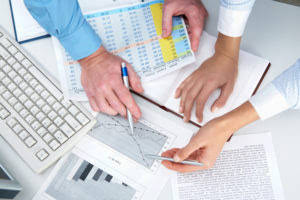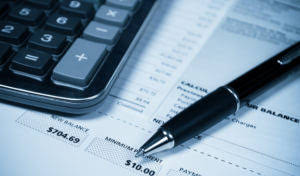Content
- What Happens To Accumulated Depreciation When I Sell The Asset?
- How To Calculate Variable Contribution Margin
- An Example Of Accumulated Depreciation And Asset Value
- What Is Accumulated Depreciation, And How Does It Impact Your Assets Value?
- Understanding Accumulated Depreciation
- What Is Accumulated Depreciation Classified As On The Balance Sheet?

Pre-depreciation profit includes earnings that are calculated prior to non-cash expenses. Subsequent years’ expenses will change based on the changing current book value. For example, in the second year, current book value would be $50,000 – $10,000, or $40,000. For example, if a company purchased a piece of printing equipment for $100,000 and the https://www.bookstime.com/ is $35,000, then the net book value of the printing equipment is $65,000. Depreciation expense is the cost of an asset that has been depreciated for a single period, and shows how much of the asset’s value has been used up in that year. Depreciation is an accounting method that spreads out the cost of an asset over its useful life.
- That said, nothing is stopping you from using this method of depreciation for all of your assets.
- For this reason, the type of assets that accumulate depreciation are assets that are capitalized.
- The first year’s depreciation expense is $3,000, or $0.15 times 20,000.
- Each person should consult his or her own attorney, business advisor, or tax advisor with respect to matters referenced in this post.
- Determine the accumulated depreciation at the end of 1st year and 3rd year.
Depreciation expense is recorded on the income statement as an expense or debit, reducing net income. Accumulated depreciation is not recorded separately on the balance sheet. Instead, it’s recorded in a contra asset account as a credit, reducing the value of fixed assets. The accumulated depreciation account is a contra asset account on a company’s balance sheet.
Businesses depreciate long-term assets for both accounting and tax purposes. Generally, the cost is allocated as depreciation expense among the periods in which the asset is expected to be used. A fixed asset, however, is not treated as an expense when it is purchased. The full value of the asset is shown on the company’s balance sheet. Over its useful life, the asset’s cost becomes an expense as it declines in value year after year. The declining value of the asset on the balance sheet is reflected on the income statement as a depreciation expense.
What Happens To Accumulated Depreciation When I Sell The Asset?
Depletion and amortization are similar concepts for natural resources and intangible assets, respectively. Then we add up the digits of each year of the asset’s useful life, hence the name. The Sum-of-the-Years’ Digits is another accelerated method of asset depreciation. For the last year of the asset’s useful life, the formula will not be used. 5 years is the estimated useful life of the asset as it is the expected number of years that the asset will be useable. That said, nothing is stopping you from using this method of depreciation for all of your assets. The straight line method is probably the simplest method of depreciation.

Even then, the accumulated depreciation cannot exceed the asset’s original cost, despite remaining in use after its estimated useful life. Now, as Waggy Tails will use the equipment for the next ten years, it will expense the cost of the equipment for the entire period. Using the straight-line depreciation method, Waggy Tails finds that the asset will depreciate by $10,000 a year for the next ten years until its book value is $10,000.
Most businesses have assets and the value of these assets changes over time. These changes affect the value of your business and your business taxes. Examples are accumulated depreciation against equipment, and allowance for bad debts against long-term notes receivable. Salvage ValueSalvage value or scrap value is the estimated value of an asset after its useful life is over. For example, if a company’s machinery has a 5-year life and is only valued $5000 at the end of that time, the salvage value is $5000. If you are also familiar with provision for loan or account receivable, these are also the contra account of loans or receivables so that the loan or AR will be reported at the net in the balance sheet. Like many accounting concepts, accumulated depreciation is a must-know to run your back office successfully.
How To Calculate Variable Contribution Margin
Yes, you should have a dedicated accumulated depreciation sub-account for every asset your business is depreciating. Each account name should start with “accumulated depreciation” followed by the name of the asset.
- For example, if a company’s machinery has a 5-year life and is only valued $5000 at the end of that time, the salvage value is $5000.
- Depreciation is technically a method of allocation, not valuation, even though it determines the value placed on the asset in the balance sheet.
- The accumulated depreciation account is acontra asset accountthat lowers thebook valueof the assets reported on the balance sheet.
- Accumulated depreciation on 31 December 2019 is equal to the opening balance amount of USD400,000 plus depreciation charge during the year amount USD40,000.
- Over the years the machine decreases in value by the amount of depreciation expense.
- The accumulated depreciation for an asset or group of assets increases over time as depreciation expenses are credited against the assets.
Alex will have to recognize a monthly depreciation expense of $2,000 for this particular asset. The straight line method is most suited to assets that you know will be operating at relatively the same level over its useful life. This means that you won’t see the actual amount of accumulated depreciation on the balance sheet. If its accumulated depreciation is near equal to its original cost, the asset is probably near the end of its useful life. Present the asset’s original cost on the balance sheet; this way, we won’t have to look for the original documentation of the asset just to know of its original cost. For example, accumulated depreciation – machinery offsets the balance of the machinery account. In accounting, we refer to the deterioration of assets as depreciation.
An Example Of Accumulated Depreciation And Asset Value
The amount of a long-term asset’s cost that has been allocated, since the time that the asset was acquired. In all probability, you will find accumulated depreciation listed as a credit balance just below the fixed assets on the balance sheet. If you don’t see it next to the fixed assets, you may notice a column listing the net costs for property, plant, and equipment. In this case, you can head to the financial statement disclosures to find details about the book value of the company’s assets.

This deduction is fully phased out for businesses acquiring over $2,000,000 of such property during the year. In addition, additional first year depreciation of 50% of the cost of most other depreciable tangible personal property is allowed as a deduction. Some other systems have similar first year or accelerated allowances.
What Is Accumulated Depreciation, And How Does It Impact Your Assets Value?
Depreciation is the method of accounting used to allocate the cost of a fixed asset over its useful life and is used to account for declines in value. It helps companies avoid major losses in the year it purchases the fixed assets by spreading the cost over several years. Some companies don’t list accumulated depreciation separately on the balance sheet. Instead, the balance sheet might say “Property, plant, and equipment – net,” and show the book value of the company’s assets, net of accumulated depreciation.
- These changes affect the value of your business and your business taxes.
- Tracking the depreciation expense of an asset is important for reporting purposes because it spreads the cost of the asset over the time it’s in use.
- The four methods allowed by generally accepted accounting principles are the aforementioned straight-line, declining balance, sum-of-the-years’ digits , and units of production.
- For every asset you have in use, there is the “original basis” and then there’s the “accumulated depreciation” .
- Simultaneously, each year, the contra asset account or accumulated depreciation will increase by $10,000.
- This depreciation expense is taken along with other expenses on the business profit and loss report.As the asset ages, accumulateddepreciation increases and the book value of the car decreases.
- Eventually, when the asset is retired or sold, the amount recorded in the accumulated depreciation and the asset’s original cost will be reversed.
The Administrative Agent’s office located at Bijlmerplein 888, 1102 MG Amsterdam, The Netherlands, or at such other location as the Administrative Agent may designate from time to time. ING Bank N.V., acting as administrative agent for the Lenders, and each other Person appointed as the successor Administrative Agent in accordance with §14.9. Accumulated depreciation is the sum of depreciation costs charged to an asset.
Understanding Accumulated Depreciation
It appears as a reduction from the gross amount of fixed assets reported. Accumulated depreciation specifies the total amount of an asset’s wear to date in the asset’s useful life.
If the amount received is greater than the book value, a gain will be recorded. If the amount received is less than the book value, a loss is recorded.

Where the assets are consumed currently, the cost may be deducted currently as an expense or treated as part of cost of goods sold. The cost of assets not currently consumed generally must be deferred and recovered over time, such as through depreciation. Some systems permit the full deduction of the cost, at least in part, in the year the assets are acquired. Other systems allow depreciation expense over some life using some depreciation method or percentage.
As the value of land is appreciating; hence land is not a depreciable asset. Accumulated depreciation on 31 December 2019 is equal to the opening balance amount of USD400,000 plus depreciation charge during the year amount USD40,000. GoCardless is authorised by the Financial Conduct Authority under the Payment Services Regulations 2017, registration number , for the provision of payment services. Tax TipsA Beginner’s Guide to Record-Keeping for Small Businesses Get an overview of all the different records and receipts you have to maintain as a small business owner and how to manage them efficiently.
The depreciation expense per unit equals the depreciable cost divided by the number of units of output the business expects the asset to produce over its life. You might use miles driven for a vehicle, printed pages for a copy machine or machine-hours for a piece of equipment. Using the previous example, assume you expect to drive the vehicle for 100,000 miles over its life. The depreciation expense per mile equals $0.15, or $15,000 divided by 100,000. Accumulated depreciation is the total decrease in the value of an asset on the balance sheet of a business, over time.
Accumulated Depreciation is not considered an asset because assets represent something that will produce economic value to the enterprise over the past. And accumulated depreciation does not produce the organization’s economic value as accumulated depreciation itself shows the credit balance. Hence the value of accumulated depreciation does not represent something that produced economic value, whether in the past or the future.
This means that a company charges most of an asset’s depreciation expenses during the beginning years of the asset’s use, starting when the company gains the asset. In later years as the asset loses usability and value, the company assumes a reduction in depreciation of the asset’s value. Accumulated amortization and accumulated depletion work in the same way as accumulated depreciation; they are all contra-asset accounts. The naming convention is just different depending on the nature of the asset.
Therefore it must be balanced as an asset account with a credit balance . It will appear as a deduction from the gross amount of fixed assets reported. Accumulated Depreciation is credited whenever depreciation expense is debited each accounting period, resulting in an increasing credit balance on the balance sheet. Accumulated depreciation is the sum of depreciation expenses over the years. The carrying amount of fixed assets in the balance sheet is the difference between the asset’s cost and the total accumulated depreciation and impairment.
Straight Line Method
Keeping track of income as well as expenses is hence not a choice but is a mandatory requirement in any business. The reduction of the value of an asset over time, commonly referred to as depreciation, is among the expenses that are incurred in the running of a business, regardless of the value of assets. It is hence important to differentiate between accumulated depreciation and depreciation expense. For year five, you report $1,400 of depreciation expense on your income statement.
In the second year, you will deduct the total depreciation expense from the purchase price ($110,000 – $20,000) and follow the same formula. The reason is that current assets are not depreciated because they are not expected to last for more than a year. Accumulated depreciation is an accounting term used to assess the financial health of your business.
Each year the contra asset account referred to as accumulated depreciation increases by $10,000. For example, at the end of five years, the annual depreciation expense is still $10,000, but accumulated depreciation has grown to $50,000. It is credited each year as the value of the asset is written off and remains on the books, reducing the net value of the asset, until the asset is disposed of or sold. It is important to note that accumulated depreciation cannot be more than the asset’s historical cost even if the asset is still in use after its estimated useful life. Bookkeeping 101 tells us to record asset acquisitions at the purchase price — called the historical cost — and not to adjust the asset account until sold or trashed. Businesses subtract accumulated depreciation, a contra asset account, from the fixed asset balance to get the asset’s net book value. Accumulated depreciation is an asset account with a credit balance known as a long-term contra asset account that is reported on the balance sheet under the heading Property, Plant and Equipment.
Let’s say you want to look at how much depreciation is already recorded for a particular asset. If you use an asset, like a car, for both business and personal travel, you can’t depreciate the entire value of the car, but only the percentage of use that’s for business. For example, if you use your car 60% of the time for business and 40% for personal, you can only depreciate 60%. Accumulated depreciation is shown in the face of the balance sheet or in the notes.
The straight-line method is the simplest method for calculating accumulated depreciation. In this method, you depreciate an asset at an equal amount over each year across its useful life. The journal entries for the accumulated depreciation will help you determine how much of an asset has been written off and its remaining useful life. You must know the salvage value of the asset you’re evaluating to calculate the total accumulated depreciation for the year using the straight-line method. The salvage value of an asset is the amount you expect to receive once the asset is no longer in use. Find this value by estimating the total value you expect to have reselling, retiring or scrapping an asset. A depreciation schedule is required in financial modeling to link the three financial statements in Excel.

Recent Comments